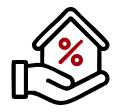Home Equity Line of Credit Requirements Checklist
KEY TAKEAWAYS
- To qualify for a HELOC, you typically need at least 15-20% home equity, along with a steady income and a credit score of 640 or higher.
- Lenders evaluate debt-to-income (DTI) ratio, employment status, and overall financial stability to determine eligibility.
- A higher credit score and lower DTI can improve your chances of approval and help secure better loan terms, such as a fixed-rate HELOC.
- Understanding cash-out refinance vs. HELOC and using funds wisely can maximize the benefits of borrowing against your home’s equity.



 Outstanding Client Experience
Outstanding Client Experience Specialized Lending Solutions
Specialized Lending Solutions Direct-to-Consumer Advantage
Direct-to-Consumer Advantage We're Advisors, NOT Salespeople
We're Advisors, NOT Salespeople Effortless Digital Mortgage Platform
Effortless Digital Mortgage PlatformA home equity line of credit (HELOC) allows homeowners to borrow against their home’s equity, offering flexibility similar to a credit card.
To qualify, lenders typically assess factors like credit score, income, debt-to-income ratio, and home equity. Understanding these requirements can help determine if a HELOC is the right financial tool for your needs.

KEY TAKEAWAYS
- To qualify for a HELOC, you typically need at least 15-20% home equity, along with a steady income and a credit score of 640 or higher.
- Lenders evaluate debt-to-income (DTI) ratio, employment status, and overall financial stability to determine eligibility.
- A higher credit score and lower DTI can improve your chances of approval and help secure better loan terms, such as a fixed-rate HELOC.
- Understanding cash-out refinance vs. HELOC and using funds wisely can maximize the benefits of borrowing against your home’s equity.
How Does a Home Equity Line of Credit Work?
A home equity line of credit (HELOC) is a revolving line of credit that allows homeowners to borrow against their home’s equity as needed. Unlike a traditional loan, it provides ongoing access to funds during a draw period, followed by a repayment phase. While HELOCs typically have variable interest rates, some lenders offer a fixed-rate option for more predictable payments.
It’s important to understand how a home equity loan works compared to a HELOC, as the former provides a lump sum with fixed payments, whereas a HELOC offers flexibility with borrowing and repayment.
This makes HELOCs ideal for expenses like home renovations, ongoing projects, or unexpected costs, giving homeowners greater control over their finances. However, because your home serves as collateral, it’s essential to borrow responsibly and have a repayment plan.
Home Equity Line of Credit Requirements: A Checklist
A home equity line of credit (HELOC) can be a valuable financial tool, but qualifying requires meeting certain criteria. Lenders evaluate multiple factors to ensure borrowers can repay the loan and have enough equity in their homes to secure it.
Understanding these key requirements can help you determine eligibility and prepare for the application process.
Minimum Equity Requirements
To qualify for a HELOC, you typically need at least 15-20% equity in your home. Equity is the difference between your home’s market value and the remaining balance on your mortgage. Lenders use this as collateral, ensuring you have a financial stake in the property.
The more equity you have, the higher your borrowing potential, which is why some homeowners weigh cash-out refinance vs. HELOC when deciding how to access their home’s value. A higher equity percentage can also improve your chances of securing better loan terms, such as a larger credit limit or a lower interest rate.
Income
Lenders assess your income to ensure you have the financial stability to make payments on your HELOC. A steady, verifiable income demonstrates your ability to handle additional debt, reducing the lender’s risk.
While there’s no set income requirement, higher earnings can improve your chances of approval and secure better loan terms. If you have multiple income sources, such as rental properties or investments, providing documentation can help strengthen your application.
Borrowers with variable income, such as freelancers or business owners, may need to provide additional financial records to prove income consistency or apply for a bank statement loan HELOC.
Credit Score
Your credit score plays a major role in determining your eligibility and interest rate for a HELOC. Most lenders require a score of at least 640, though a higher score (typically 700 or above) can help you qualify for better terms, such as lower interest rates or a fixed-rate HELOC option.
A strong credit history shows lenders that you’re a responsible borrower, making them more likely to approve your application. If your credit score is lower, you may still qualify, but you could face higher interest rates or stricter borrowing limits. Taking steps to improve your credit, such as paying down existing debt and making on-time payments, can help boost your eligibility.
DTI Ratio
Your debt-to-income (DTI) ratio compares monthly debt payments to gross income. Lenders typically prefer a DTI ratio below 43%, though lower is always better. A manageable DTI signals that you aren’t overextended financially and can handle additional debt from a HELOC without straining your budget.
If your DTI is too high, reducing existing debt before applying for a HELOC can improve your chances of approval. Lenders may also consider compensating factors, such as high savings balances or strong credit history, to offset a slightly higher DTI.
Employment Status
Stable employment reassures lenders that you have a reliable income source to repay the HELOC. While full-time employment is ideal, self-employed individuals can also qualify by providing either tax returns, profit-and-loss statements, and other financial documentation or 12 months’ worth of bank statement deposits.
Consistent job history and steady earnings can strengthen your application. Lenders may require additional proof of employment stability if you’ve recently changed jobs, such as an offer letter or multiple months of pay stubs. For retirees or individuals with non-traditional income sources, alternative documentation, like investment account statements, may be necessary.
Loan Purpose
Lenders often ask about your intended use for a HELOC. While these funds can be used for various purposes—such as home improvements, debt consolidation, investing in assets, or unexpected expenses—using them wisely can impact your financial well-being.
Borrowing for investments that increase home value, like renovations, is typically viewed more favorably than using a HELOC for discretionary spending. However, some lenders may restrict the use of HELOC funds for certain expenses, such as purchasing additional properties or paying off specific types of debt.
Being clear about your loan purpose can help ensure you select the right financing option for your needs.

Home Equity Line of Credit Documentation Checklist
Applying for a home equity line of credit (HELOC) requires submitting various documents to verify your identity, financial standing, and homeownership status.
Lenders use this information to assess your ability to repay and determine how much you can borrow. Being prepared with the right paperwork can streamline the application process and improve your chances of approval.
Loan Application
The first step in obtaining a HELOC is completing a formal loan application with your chosen lender. This application collects details about your personal information, income, debts, and the property securing the credit line.
Providing accurate and complete information helps lenders evaluate your financial profile and determine whether you meet their eligibility requirements.
Identifying Information
Lenders require documentation to verify your identity before approving a HELOC. You’ll typically need to provide a government-issued photo ID, such as a driver’s license or passport, along with your Social Security number. This ensures that the application is legitimate and that the loan is processed in compliance with financial regulations.
Proof of Income
To confirm your ability to repay the HELOC, lenders request proof of income. Traditional employees may need to provide recent pay stubs, W-2 forms, or tax returns.
However, depending on the lender’s requirements, self-employed borrowers may be able to qualify using bank statements instead of tax returns. Demonstrating stable income can help secure more favorable terms and a higher credit limit.
Additional Documentation
Depending on your financial situation and property details, lenders may ask for supplemental documents. These may include:
- Supplemental income information: If you receive rental income, alimony, or other forms of earnings, you may need to provide supporting documents.
- Proof of homeowners insurance: Lenders require proof that your home is insured to protect their investment.
- Co-applicant information: If applying with a co-borrower, their financial details must be submitted.
- Asset verification: Bank statements, retirement accounts, or investment records may be required to show additional financial stability.
- Trust agreement (if applicable): If your property is held in a trust, lenders may need documentation confirming ownership and authority to borrow against the home.
Before applying, it’s important to weigh the pros and cons of taking out a HELOC. While it offers flexible access to funds, it’s essential to borrow responsibly to avoid financial strain. Understanding home equity loan limits can also help you determine how much you may be eligible to borrow and compare your options between HELOCs and home equity loans for the best financial fit.
Apply for a HELOC Today
A home equity line of credit can be a smart way to access your home’s value for renovations, debt consolidation, or unexpected expenses. Understanding the requirements and preparing the necessary documentation can streamline the application process and secure the best possible terms.
At Griffin Funding, we make unlocking your home’s equity easy with competitive HELOC options tailored to your financial needs. Our team is here to guide you through the process, ensuring you get the right financing solution with flexible terms and great rates. Plus, with the Griffin Gold app, you can easily manage your HELOC, track your loan details, and access exclusive benefits—all from your phone.
Get started today and see how a HELOC from Griffin Funding can help you achieve your financial goals!
Find the best loan for you. Reach out today!
Get StartedRecent Posts
Down Payment Calculator
Planning to buy a home? One of the biggest questions you’ll face is figuring out how much cash you need ...
No Capital Gains Tax on Home Sales Legislation: What to Know
The current tax structure creates challenges for homeowners who have seen their property values soar over rece...
Bank Statement Loan Document Checklist
The main difference between bank statement loans and conventional mortgages is how your income is verified. Tr...









